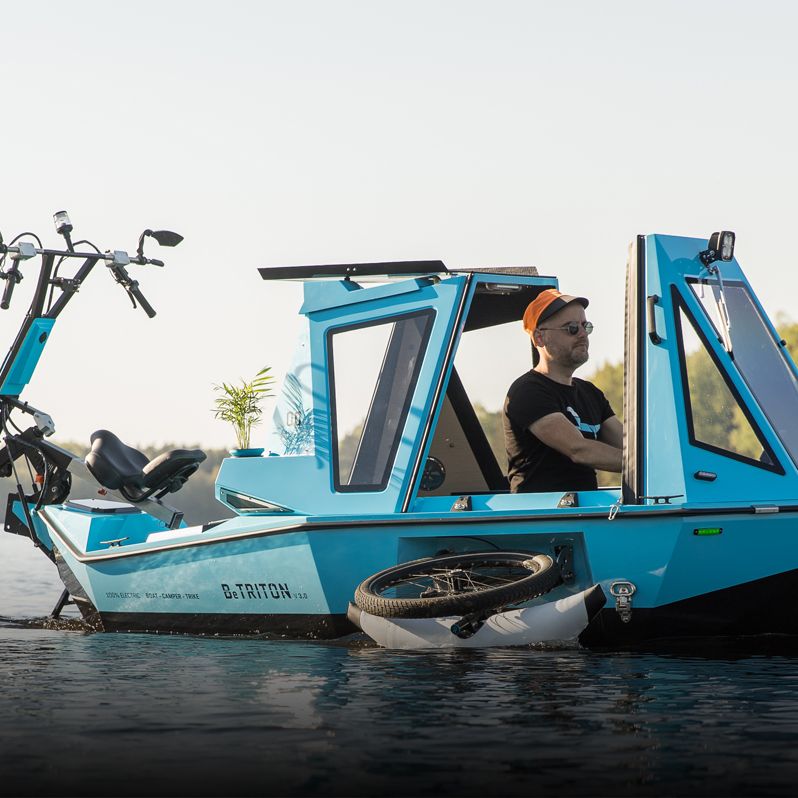02 february 2023
We all keep an eye on the tread of our tyres, especially when buying new ones, when it comes to changing them every year or, in certain countries, when we’re driving in snow. But how do tyre designers develop tread patterns in the first place? How do they combine rolling resistance, road holding in wet conditions and design considerations, for instance? And why have tyre tread patterns changed over the years? To find out more, we talked to three experts from Continental: Felix Hübner, who, as Head of Pattern & Industrial Design, is responsible for the passenger car division, Fabian Dettmer, Head of Virtual Development CVT, who is responsible for HGVs, and Peter Bogenschütz, who as Head of Industrial Design Tires, takes the complexities of tread function and presents them in a pattern that consumers can relate to.
A new generation of tyres does not arise out of thin air, of course. The first action is to collate all the experience acquired with the predecessor model, all the while asking to what extent mileage, rolling resistance or traction properties can be further improved. “We then consider how these improvements can be realised through changes in material, geometry and tread pattern,” says Fabian Dettmer. The technical experts then create a basic structure for the tread pattern. It’s at this point that industrial designers such as Peter Bogenschütz, whose job it is to develop a design for the technical concept, come into play: “Our task is to translate the technological aspects of the tyre into a design language that consumers will understand when they look at it.” A design that will allow them to tell, for example, whether the tyre will be very durable or have particularly good traction properties – i.e. whether it will respond well to quick acceleration and be safe when the brakes are applied. In the next step, the tread pattern designs are transferred into a computer program as 3D models and tested, evaluated and optimised using simulation tools. The most promising candidates are then made into physical specimens and tested on machines in the laboratory and on vehicles. “This is so that we can find out whether our hypotheses, simulations and design ideas work,” explains Bogenschütz.
From the first draft to series production
A new generation of winter tyres will be put to the test over at least two winter seasons, says Felix Hübner. “This means that you end up with a development time of several years.” For HGV tyres, this may even be one or two years longer, adds Fabian Dettmer. This is because HGV tyre prototypes are always subjected to elaborate field tests, during which they cover hundreds of thousands of kilometres. “And because they are used in regular road traffic, they have to undergo the same tests in advance and meet the requirements of normal production tyres,” says Dettmer.
© Jacobs Stock Photography, Getty Images
High requirements apply to winter tyres - the development time for a new generation of tyres can take several years.
Digital possibilities: “desk-based” testing
In the past, there was no option but to produce a large number of different test tyre variants and go through numerous optimisation loops until they were ready for series production. “Thanks to the simulations, we’re now able to evaluate several solutions in advance to enable us to directly select the most interesting tread pattern concepts,” explains Felix Hübner. Desk-based testing in this way saves a lot of material: metal for the production machines, rubber for the tyres. “This allows us to develop our tyres in a much more targeted manner, even with all the more stringent legal requirements,” says Hübner. But one thing has until now been virtually impossible to simulate: the impact of combining different blends of rubber on tyre properties. “We’ve made a start with some new approaches here, but they aren’t yet as mature as the tread patterns.”
From block to band: how tyre tread patterns have changed
A distinctive tread pattern combining small blocks with lots of transverse grooves used to be the measure of all things, especially with HGVs. “For consumers, this block structure was synonymous with grip and motive power,” says Peter Bogenschütz. Not least due to the EU tyre label, which makes tyre properties visible to consumers, other factors have in the meantime become increasingly important: how much noise a tyre generates or how easily it rolls – in other words, how much fuel it consumes. And mileage is becoming increasingly important, especially in the HGV sector, adds Fabian Dettmer. “A circumferential band structure is much more suitable for achieving these goals.” What this means in practice is structures that are less open, with fewer grooves, and more rubber overall. This also makes for improved braking on dry roads. It’s a different story in the rain, however, because more numerous and deeper grooves can displace more water. In principle, at least. “Over the last 20 years, the grip achieved with rubber compounds has improved significantly. That’s why we’re now achieving even better wet grip properties with far fewer transverse grooves than was the case with previous generations of tyres with a strong tread pattern,” explains Peter Bogenschütz.
Gently changing habitual perceptions
One of the tasks of industrial designers is to ensure that, even when the technical basis has changed, a new tyre will still look a little like its predecessor – thereby taking into account the habitual perceptions of car and HGV drivers. “Customers want to see blocks, by which I mean transverse edges. That’s why we added elements which looked like transverse edges to the bands when switching to the band structure for our sports tyre model.” The following generation then hit the road with considerably fewer transverse edges. “This approach allows us to gradually change habitual perceptions over successive generations,” says Bogenschütz.
Why the tread can make tyres louder – or quieter
As the tyres roll, the air in the grooves gets compressed and pushed out. The wider and deeper the grooves, the louder the noise. Tread blocks also generate vibrations throughout the tyre when they hit the road surface, which the sidewall then amplifies like a loudspeaker, reports Felix Hübner. “With band structures, this doesn’t happen, which makes the tyres quieter.” This is why winter tyres with more aggressive tread patterns are always a bit louder than summer tyres, adds Fabian Dettmer. And the more evenly the tread blocks hit the ground, the noisier the tyre is for occupants and passers-by. “In tyre design, we have to counteract this annoying rule of tyre behaviour by using what we call phase shifts.”
(Tyre) treads for every taste
One of the effects of the new technical possibilities and increased consumer expectations is that there are now significantly more tyre models available for different applications and preferences. In Asia, having the quietest and most comfortable tyres possible is much more important to drivers than it is in the rest of the world, says Peter Bogenschütz. “And this results in the creation of special models, of course, which then also have to look different.”
Why tyres are getting bigger and bigger
Car tyres have increased relentlessly in height and width in recent years. This has to do with the aesthetic preferences of drivers – and with the greater engine power of today’s passenger cars. Whereas in 1995 the power output of the average car was 95 bhp, by 2020 it had leapt to 165 bhp, according to an assessment by the Duisburg CAR Institute. “And with these higher performance cars, wider tyre contact surfaces offer an advantage when it comes to transferring the motive power to the road,” explains Felix Hübner. This is important to allow today’s increasingly heavy cars to accelerate and brake faster. “What has also driven this trend toward bigger and wider tyres is the consumer demand for cars that will corner as if they were on rails,” says Hübner. When it comes to reducing consumption, tall and narrow tyres offer a decided advantage, the expert adds. As the name suggests, these are narrow tyres with large diameters that are lighter and more aerodynamic than conventional tyres. “And the increase in diameter also reduces tyre deformation, which leads to lower rolling resistance,” explains Hübner. Low rolling resistance means less energy consumption – which is why one of the significant attractions of tall and narrow tyres is their possible use as “range extenders” for electric cars.
© Yevhen Rychko, Getty Images
Car tyres became larger and wider over time, also in order to be able to corner ever more smoothly.





